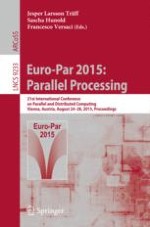This book constitutes the refereed proceedings of the 21st International Conference on Parallel and Distributed Computing, Euro-Par 2015, held in Vienna, Austria, in August 2015. The 51 revised full papers presented together with 2 invited papers were carefully reviewed and selected from 190 submissions. The papers are organized in the following topical sections: support tools and environments; performance modeling, prediction and evaluation; scheduling and load balancing; architecture and compilers; parallel and distributed data management; grid, cluster and cloud computing; distributed systems and algorithms; parallel and distributed programming, interfaces and languages; multi- and many-core programming; theory and algorithms for parallel computation; numerical methods and applications; and accelerator computing.
